Are you a Quiet Speculation member?
If not, now is a perfect time to join up! Our powerful tools, breaking-news analysis, and exclusive Discord channel will make sure you stay up to date and ahead of the curve.
If you liked "dies to Doom Blade," you're gonna love "dies to Fatal Push!" Few are more surprised than I to see a great black removal spell grace the Aether Revolt spoiler page, though initial evaluations largely seem to be calling the card something it's not. It's a solid card with a role to play, but not the sort of card that redefines formats as large and diverse as Modern. Today I'm going to break down Fatal Push, what the card means for Modern, and close with an updated list for Grixis Delver.
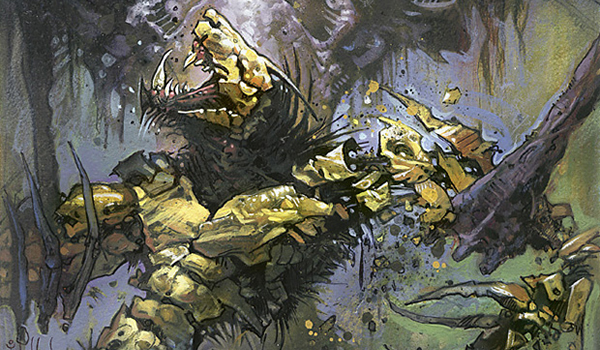
I suppose talking about a newly spoiled card merits posting the textbox for reference. Here is the card that many are saying will redefine Modern:
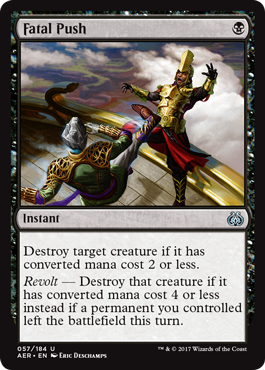
Calling Fatal Push the black Path to Exile is a reasonable comparison, though it's not wholly accurate. Either way, people are going to call it that, so get used to it. The two cards are sort of opposites though, as Path to Exile is quite bad on turn one and gets better, whereas Fatal Push is exceptional on turn one and scales somewhat poorly.
[wp_ad_camp_1]
Strengths
The fact that Fatal Push checks on mana costs but doesn't care if the targeted creature is a land makes it great against both Noble Hierarch and Inkmoth Nexus (animated lands have a converted mana cost of zero, in case that wasn't obvious). More one-mana interaction to combat Infect is something plenty of Modern decks are in the market for, and Fatal Push is great for this purpose.
 In a format so heavily defined by efficiency, that mana cost restriction looks way more appealing than toughness-based removal. Fatal Push doesn't care how big your Tarmogoyf, Monastery Swiftspear, Arcbound Ravager, or Death's Shadow has grown—it's dead all the same. Similarly, the card doesn't get fizzled by traditional pump spells like Mutagenic Growth. This is a blind spot for most of the efficient removal in Modern: Lightning Bolt, Darkblast, and Dismember all look at toughness. To get an unconditional removal spell besides Path, we have to jump up the curve to Terminate and Abrupt Decay. Filling this gap at the one-mana spot is where Fatal Push will really shine.
In a format so heavily defined by efficiency, that mana cost restriction looks way more appealing than toughness-based removal. Fatal Push doesn't care how big your Tarmogoyf, Monastery Swiftspear, Arcbound Ravager, or Death's Shadow has grown—it's dead all the same. Similarly, the card doesn't get fizzled by traditional pump spells like Mutagenic Growth. This is a blind spot for most of the efficient removal in Modern: Lightning Bolt, Darkblast, and Dismember all look at toughness. To get an unconditional removal spell besides Path, we have to jump up the curve to Terminate and Abrupt Decay. Filling this gap at the one-mana spot is where Fatal Push will really shine.
While Fatal Push will be quite powerful against all the linear aggressive decks, I don't feel that its weaknesses have been discussed nearly as much as necessary. If you're interested in playing a black deck that struggles against linear aggro, this card definitely helps you there. It will matter in plenty of other spots as well. That said, there are other factors that should be considered before sleeving up four Fatal Pushes and claiming invincibility.
Weaknesses
The Revolt Mechanic
Revolt is a quirky mechanic, but we're already starting to get a good idea of how to turn it on. By now you probably know of the interaction with fetchlands. The critical mistake I'm seeing many commentators make is assuming that revolt will always be on because fetches are legal in Modern. Revolt is easy. It's not free. You will play games where you can't kill a three- or four-mana creature with your Fatal Push. Imagine needing to topdeck a fetchland to kill half of a Kitchen Finks. 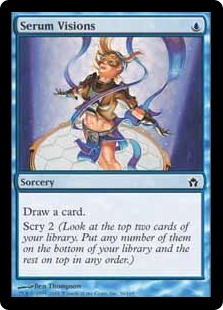 This drawback is non-trivial, even for tagging three- and four-drops, and trying to classify Fatal Push as unconditional removal is simply inaccurate.
This drawback is non-trivial, even for tagging three- and four-drops, and trying to classify Fatal Push as unconditional removal is simply inaccurate.
Fatal Push is being discussed mostly as a card for blue-black controlling strategies. Control decks can suffer from the problem of removal not lining up against threats, when they expect to kill everything the opponent does over a long game. Conditional removal is usually necessary in some number, but that's why you see a mix of different answers, usually in numbers smaller than four. Fatal Push likely won't be any different here. Turning on revolt is also complicated by a tension with shocklands and Serum Visions. To fix their mana and save some life, these controlling decks frequently want to fetch a dual on turn one. With Serum Visions in your deck, you're incentivized to fetch as soon as possible so the scrying will be relevant. This obviously competes with Fatal Push's desire for sandbagged fetches.
There are absolutely matchups and games where the revolt doesn't especially matter, but don't pretend like enabling it is free. If you play Fatal Push long enough, you'll eventually lose to a three-mana creature with it stuck in your hand.
Sticky Creatures
While it is true that Fatal Push excels in a number of matchups, it sure sucks against Dredge. I am aware that not everything can be good against Dredge, though that is one of the prime matchups that tends to give control decks problems. I know that's the matchup Grixis Delver is most interested in trying to shore up right now, and it's not like Jund or Abzan need to increase their percentage against the linear decks either. 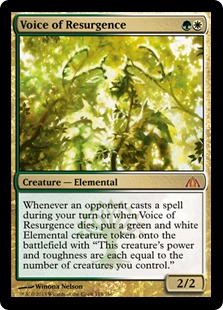 You can have a good game-one matchup against Infect without really costing yourself much of anything, but that's not especially true against fair decks or Dredge. I get that efficient exiling removal is a big ask given the splash damage against cards like Voice of Resurgence, but that's really what these decks are in the market for.
You can have a good game-one matchup against Infect without really costing yourself much of anything, but that's not especially true against fair decks or Dredge. I get that efficient exiling removal is a big ask given the splash damage against cards like Voice of Resurgence, but that's really what these decks are in the market for.
On the topic of Voice of Resurgence, creatures of this nature gain a lot of value as players run more Fatal Pushes. Yes, a one-mana exiling removal spell would be extremely pushed and powerful. I'm not saying that they should print such a card or that it would necessarily be reasonable. I am saying that a card of this nature is the type of removal spell that these fair decks actually want to address their weaknesses. Kalitas, Traitor of Ghet certainly helps in this regard, though is quite slow against the Dredge menace. Perhaps we'll be lucky enough to see that deck banned though. One can dream, right?
Creatures with a High Mana Cost
This one is obvious and only matters in a handful of situations in Modern, though it's worth taking note of. 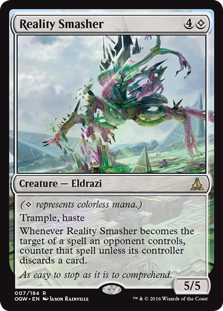 I've seen Primeval Titan referenced specifically in this regard, though you're usually dead if that one hits the battlefield anyway. Same story with Griselbrand. Where this matters is against Reality Smasher and delve creatures.
I've seen Primeval Titan referenced specifically in this regard, though you're usually dead if that one hits the battlefield anyway. Same story with Griselbrand. Where this matters is against Reality Smasher and delve creatures.
Frankly, as a Grixis Delver player I'm excited to hear that people want to shave Terminate for this card. Delver of Secrets already dies to everything. I am thrilled when your removal spells can't kill Tasigur, the Golden Fang. On the matter of Reality Smasher, that and the fact that revolt isn't free make it so that Bant Eldrazi isn't terribly upset if you want to play a bunch of Fatal Pushes. Somebody had the audacity to say to me that the same is true of Lightning Bolt, because he was apparently under the impression that Fatal Push can deal 3 damage to players. This downside only pertains to a handful of creatures, but to act as if this is irrelevant is absurd.
Trying to Kill Urza's Tower
As far as playable removal spells go, Fatal Push is certainly one of them. I expect the card to see play. It kills some things better than existing tools, and performs more poorly than those same tools in other areas. The card will see maindeck play, though it will not revolutionize Modern. It's good for what it does, though what matters more is what it's not. 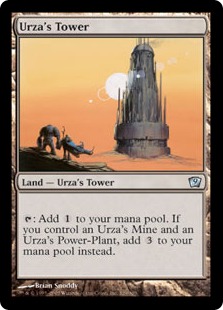 Ultimately, even if Fatal Push were convincingly the best removal spell in Modern, it wouldn't solve the biggest problem that control decks have.
Ultimately, even if Fatal Push were convincingly the best removal spell in Modern, it wouldn't solve the biggest problem that control decks have.
More than anything, control decks in Modern are hurting for a way to get reasonable odds against Tron. It is true that Fatal Push makes it easier for black decks to take down linear aggressive decks. It is absolutely true that it is the best removal spell for a single black mana in the format. The issue is that control and midrange decks can already hold their own against aggressive decks. If Fatal Push is widely adopted and pushes these aggressive decks out, suddenly Tron—one of your worst matchups—gets better!
Don't get me wrong. Fatal Push is good, and will see both maindeck and sideboard play in Modern. It just isn't what control decks need to get better in the format. It's not a catchall, and there are good strategies against control decks that just ignore it. My initial read is that I want to try playing one copy in the Grixis Delver maindeck and go from there, though I find it unlikely that I end up with more than two in the 75. Decks like Grixis Control and BGx might want to play more copies, though these decks will continue to have the same weaknesses as before.
Brief Delver Update
Some of you are interested in an updated Grixis Delver list, and I think that's worth discussing. I'm not interested in trimming Terminate, because Infect isn't a notable weak point for Grixis Delver whereas Bant Eldrazi is. My most recent list has a maindeck Dismember that will very often be worse than Fatal Push.
Jeskai Nahiri has largely dropped off the Tier 1 map and the Grixis Delver mirror has become more of a thing. So while I'm moving things around I think it's wise to turn the Vendilion Clique into the second Kolaghan's Command. Kevin Jones and Jim Davis had it, and that card matters a ton in the mirror. It's worth noting that I would keep the sideboard Go for the Throat specifically to combat Bant Eldrazi, as it's also totally fine against Death's Shadow.
Grixis Delver, by Ryan Overturf
These changes are quite minor, of course, though I will say that I am way happier with a miser's Fatal Push than a Dismember. It's a totally fine card, though not one that lines up as well in Modern as the hype seems to suggest.
Thanks for reading.
-Ryan Overturf
@RyanOverdrive on Twitter




Interesting perspective although I think you’re overestimating the bad matchups importance.
What I mean is grixis delver is a complete dog to dredge, tends to get rolled on by bant and eldrazi taxes as well.
Control is generally great vs eldrazi but weak to tron and dredge.
Being able to shore up your mildly positive matchups (infect is like 55%. Going to 60 painlessly helps) and your rough and tumble matchups like gbx getting a ton better help you over a tournament.
My current controlling list is using spreading seas to help fight tron a bit but as splash hate for tons of other decks like jund.
I don’t think control is anywhere near unplayable in modern. People get a bit old fashioned about it as you’ve said. Grixis delver is definitely a control deck as well. Again as you’ve said .
I feel like I’m not going to get out efficiencies as often anymore. It really hurts to spend two to three mana over and over vs burn and zoo.
Having a different turn 1 removal option is amazingly useful. But really just a few percentage points
Ryan,
Great article! Do you think this may end up slowing the format down at all? I saw somewhere that this was WotC trying to slow modern down. Do you believe that is true?
Lastly, do you believe that this will enable Mardu decks to take a spot in the Teir list in 2017?
Thanks for the great article
It kind of depends on what the banlist update looks like. It absolutely adds a tool that is great against the fastest decks, but you still have to be fast for reasons alluded to in this article. There’s still Tron. There’s still Dredge. It’s existence makes the blisteringly fast decks worse, though there is plenty of stuff that ends games quickly that shrugs this off.
Mardu isn’t something I’m terribly versed on. I know that there is a Nahiri Modern deck that put up results on Magic Online for a minute, and this card certainly makes Lingering Souls look better if it becomes popular. I don’t know why you would want to be that deck over a Snapcaster Mage deck though.
Heh, I’ve been running a BWC Eldrazi Processors deck with 4 MB Relics and 4 Lingering Souls for many months now, and I guess that I want to be “that” deck because in my case that deck just straight up beats the Snapcaster decks.
With fetches and Relic to enable Push, and Souls and Smasher to resist it, I’m thinking my rogue midrange build is looking pretty good going forward.
Thanks for writing!
Thanks for being the voice of reason on this. From the state of the discourse, you’d think this card was going to turn the format upside down. I expect it to replace any of the remaining copies of Dismember and Murderous Cut currently in circulation for midrange and control decks, and give decks like Esper and BG Rock (which often bemoaned their lack of good 1-drop removal) a bit more legs, but that’s the extent of the impact I foresee.
As for your list… I’m surprised to see 0 Electrolyzes or Izzet Staticasters in your 75. You mentioned the mirror, where those cards are awesome. Abzan is also on a bit of an uptick, and it deals really well with Lingering Souls. Thoughts?
The maindeck Electrolyze is good in the mirror, though post-board you should be boarding Delver out. Staticaster is quite good against Dredge, which is the only reason I would touch that card. The deck definitely needs to be lean, which is why I moved away from the Electrolyze, and the second K Command will generally be better- particularly in the mirror, which is all about Snapcaster Mage. I could see adding a Staticaster to the board, though the motivation would be as a fifth card to bring in against Dredge. We’ll see if Lingering Souls gets more popular, at which point you need to do things more radical than changing 1-2 slots.
Why just comparing fatal push to path and not to bolt?
I think it will more often end up in the bolt slot than in the path slot in a control deck.
As a creature removal push definitly is less conditional than bolt while bolt of course is a more flexible card.
I don’t see Modern shifting past the point of where having avenues to end the game quickly defines the best and most popular decks. For this reason, I don’t see Lightning Bolt going anywhere.
Facts:
Without Revolt, this spell kills 30 of the top 50 of creatures in Modern according to Mtg Goldfish Format staples page (includes Simian Spirit Guide, Stinkweed Imp, Golgari Grave Troll, & Street Wraith)
With Revolt, this spell kills xx of the 41 of the top 50 creatures in Modern according to Mtg Goldfish Format staples page.
Note this does not include weighted averages, as the value of this card would be much higher.
https://www.mtggoldfish.com/format-staples/modern/full/creatures
I’m left to wonder whether you have a point, and how any of this matters.
Why you gotta be needlessly lashing out at people man.
Last couple of posts you’ve been doing this in all the comments. Seems pretty destructive. This guy was providing interesting data which is a huge part of what this site is about. (Not exclusively of course).
Just seems to be overly harsh as of late for not much reason
This was posted as a refutation of my analysis without any consideration for the substance of the article. This comment appears to be intentionally abrasive, and I don’t see how this makes any of my points against the card matter less. Truthfully, my article could easily be a refutation of this comment. I was just saying that those numbers are just numbers. There needs to be analysis to give them meaning.
that makes more sense. i didnt see his comment as very abrasive but it definitely is a refutation. and overall i agree with your point.
What?
All I was doing was posting the Facts about the card. Had nothing to do with being “intentionally abrasive”. I’m not one of those people who “leave comments and run” on the Internet. I have a Masters in Economics. I thought it might be useful to provide more data.
p.s. I love your work.
In that case I apologize. I did not get that from your post. You’ll definitely be interested in Sheridan’s piece on the matter then, heh.
I agree with your analysis of already existing strategies as they pertain to this card. Generally speaking, currently existing modern decks have evolved around the strength of a few removal spells: bolt, path, decay, dismember, helix (as something of an afterthought). I was pretty disappointed that your analysis didn’t discuss the potential this spell opens up by giving a good terminate impression to decks without red. To my mind, esper and sultai benefit most from this spell, as they now have a reasonable card to fill that role without requiring red or accepting the weaknesses of doom blades and dismembers.
You understand how disrespectful the use of “disappointing” is here, right? I didn’t offer any insight on decks that I don’t care about, and that I’m not an expert on. That shouldn’t be surprising. For the record, I fully expect Snapcaster Bolt to be one of the defining features of what successful control decks there are in Modern. I don’t see any reason to see why I would want to move away from needing reach to end games quickly.
I’m sorry you took my reply so negatively. Nonetheless, while I respect your analysis of the card, it’s premised on an analysis of about half of the card’s impact on the format. Enabling new color combinations is, to my mind, at least as important a facet of a card to analyze as is how it improves upon existing strategies, and, to my mind, supplies more of the gas for the kinds of comments about influencing the format that you dismiss at the article head. I’m not suggesting that the article needed to delve into archetypes and strategies you’re unfamiliar with, but presenting half of a card analysis without even a mention of the rest of its impact doesn’t seem like an effective way to tackle this kind of topic.
People will play new-ish archetypes (Sultai control isn’t really groundbreaking, heh) and some will likely be at least somewhat successful. I found it more important to address that these decks are going to have Dredge and Tron problems, so that was the angle I took. It’s certainly true that they will be better against plenty of decks.
Great article, always interested to hear your angle, though I feel you may be slightly underestimating Push, but I digress. You recently mentioned that if you were to play Grixis Delver, you’d give up the slots dedicated to beating Dredge in favor of making sure your sideboard won you other matchups. If you were to make a sideboard with that philosophy, what would it look like?
For now I left Surgicals in for this article because I think you have enough stuff for the mirror, though it’s definitely true that Fatal Push will lead to a non-zero uptick in controlling decks. I would like to see which specific strategies emerge before saying anything terribly definitive, but things like an extra land (Cavern of Souls) and more counterspells are where you want to be against blue decks. If Lingering Souls decks show up, you’re going to want to start playing Electrolyzes and possibly a Staticaster.
Great article Ryan. Is your sideboard guide still the same as your article on the dredge meta ( https://quietspeculation.com/grixis-delver-dredge-metagame/ ) or has it seen an update? Thank you for any reply.
I didn’t change the sideboard for the purpose of this article, though if we do see a radical metagame shift and/or a banning that will be reason to make some changes.
What this article really is about: Why Fatal Push is only good as one-off or two-off in Grixis Delver.
What the author thinks this article is about: Why Fatal Push is overrated in Modern.
What Fatal Push really does: Fatal Push opens up new avenues for decks like UB Control, BUG and UB Faeries to get the kill spells they couldn’t have earlier.
The Delver decklist was included as an afterthought at the end because I knew people would ask about one. The Dredge and Tron sections address your point. As the comment by Gabriel says, GB Tron may be a big winner though.
If anything, this will push the GB versions of tron with collective brutality over the top, not grixis Delver.
I agree Fatal Push won’t have much impact on Grixis Delver directly. The creatures don’t really care about it and Bolt is better in its role.
But for a deck like Abzan Midrange, which always lingers around T 1.5 this seems like yet another shot in the arm. It never had an efficient way to deal with dorks, delvers and the like that didn’t outright suck (Disfigure). The one thing Abzanites have to be careful of is replacing their paths with this, because they fill entirely different roles.
I think it will have a noticeable impact on Modern. it won’t kill the aggro decks outrights but especially decks like death’s shadow that used to thrive in bolt-heavy meta’s are going to feel this.
Abzan certainly gets better, though I think this is another spot where the second level of that adaptation is clear- Bant Eldrazi really ends up winning, as I allude to in the article.
Well, that depends. if the Paths stay in (they should IMO) and the push replaces something like the decays the deck gets better vs eldrazi IMO as it can now kill a T1 hierarch efficiently.
In the end the deck has more choices now so it gets better if configured correctly.
So basically,Abzan goes up, displaces fair decks, and leaves an open field for tron and dredge domination? Exactly what the meta needed /s